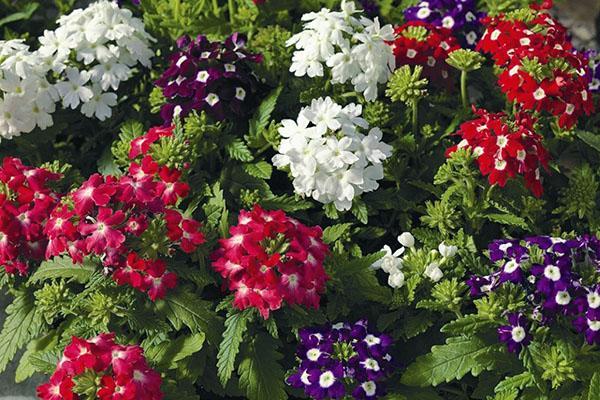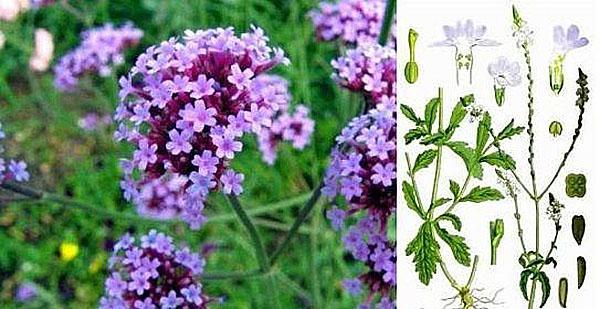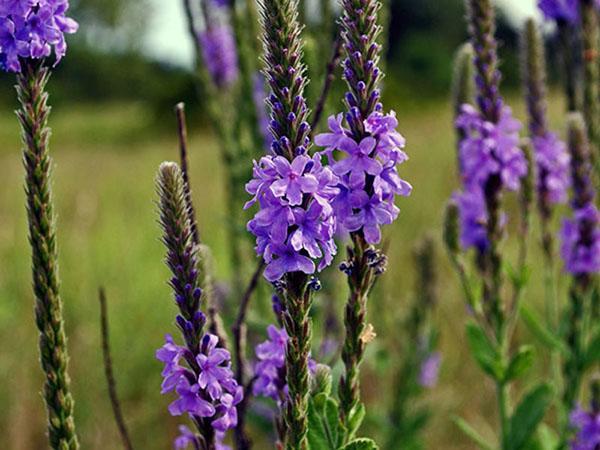Planting and caring for an extraordinary vervain in the garden
 This garden dweller has over 200 species. Below we will consider what kind of verbena plant is, planting and care necessary for lush flowering, photos of various types. For a long time, the plant carries some kind of mysticism. She guarded the hearth of the Celts and was part of the love drinks of the Druids.
This garden dweller has over 200 species. Below we will consider what kind of verbena plant is, planting and care necessary for lush flowering, photos of various types. For a long time, the plant carries some kind of mysticism. She guarded the hearth of the Celts and was part of the love drinks of the Druids.
People simply believed in this, but there is also factual evidence of its benefits. The plant is actively used by herbalists and helps to cope with many ailments. Read:Gaillardia perennial planting and care in the fall
Such a different verbena

- There are annual, perennial and semi-shrub species.
- The stems are creeping, erect, or outstretched. The leaves are also different.
- You can choose any color of the inflorescences - there are about 10. There are monophonic and flowers with an eye.
But all species have common features. Verbena is a rhizome plant. The inflorescence contains about 50 small flowers. Flowering can be observed from early summer to November. In our climate, unfortunately, verbena can only be grown as an annual - most species cannot stand frosty winters.
Now let's take a closer look at popular types of verbena and consider a photo of flowers.
Verbena long-term straight
 This is the only plant species that tolerates frost. Leaves are oval in shape with denticles at the edges, 9 by 5 cm. The flowers are lilac, the inflorescence is 40 cm in length. Flowering is short.
This is the only plant species that tolerates frost. Leaves are oval in shape with denticles at the edges, 9 by 5 cm. The flowers are lilac, the inflorescence is 40 cm in length. Flowering is short.
Verbena of Buenos Aires
From the name it is clear that the homeland of the plant is in warm countries. There, Buenos Aires verbena reaches 120 cm, grows like a perennial. It has a main stem and side shoots at the base of the bush. The leaves are long, with denticles at the edges. The flowers are light lilac. Inflorescences in the form of spikelets, which in turn form umbellate caps. Long and abundant flowering. The second name is Bonar verbena.
Verbena hybrid
 A popular species among flower growers in our region. Has creeping, branched or erect stems from 20 cm to half a meter long. Leaves are triangular in shape, with colorless bristles. Umbrella-shaped inflorescences, fragrant. Verbena hybrid can be of two subspecies:
A popular species among flower growers in our region. Has creeping, branched or erect stems from 20 cm to half a meter long. Leaves are triangular in shape, with colorless bristles. Umbrella-shaped inflorescences, fragrant. Verbena hybrid can be of two subspecies:
- large-flowered (up to half a meter high);
- compact (up to 30 cm in height).
Verbena ampelous
 There are two main varieties of ampel verbena:
There are two main varieties of ampel verbena:
- Imaging;
- Moon River.
Most often, ampelous verbena is grown in hanging pots.
Verbena officinalis
 Perennial medicinal verbena grows up to 80 cm. The leaves are oblong, the flowers are lilac, the inflorescence is in the form of a panicle.
Perennial medicinal verbena grows up to 80 cm. The leaves are oblong, the flowers are lilac, the inflorescence is in the form of a panicle.
Verbena lemon
 It grows up to 2 meters in height, the inflorescence is spicate. This species pleases with flowers from July to September. Most often, the variety is used for making oil, added to tea.
It grows up to 2 meters in height, the inflorescence is spicate. This species pleases with flowers from July to September. Most often, the variety is used for making oil, added to tea.
The healing properties of the plant
 Verbena has medicinal properties and contraindications. The latter includes individual intolerance. There are many medicinal properties, they differ in different species. Let's talk about two of the most popular.
Verbena has medicinal properties and contraindications. The latter includes individual intolerance. There are many medicinal properties, they differ in different species. Let's talk about two of the most popular.
So verbena officinalis has an excellent antispasmodic effect. Besides:
- relieves headache;
- helps with vegetative dystonia;
- normalizes blood pressure;
- diuretic;
- removes cholesterol from blood vessels.
 Verbena lemon has an antiseptic effect, is used in the treatment of vegetative-vascular dystonia, as well as:
Verbena lemon has an antiseptic effect, is used in the treatment of vegetative-vascular dystonia, as well as:
- sedative;
- antipyretic;
- used for disorders of the liver;
- helps with problems with the gastrointestinal tract;
- anti-inflammatory.

Planting verbena
 Since we grow verbena as an annual plant, let's figure out how to grow it from seeds. In some cases, seed stratification is required for germination. This will require a damp cloth, a dark bag, and a refrigerator. We put the seeds in a dampened cloth, place them in a bag and leave them in the refrigerator for 5 days.
Since we grow verbena as an annual plant, let's figure out how to grow it from seeds. In some cases, seed stratification is required for germination. This will require a damp cloth, a dark bag, and a refrigerator. We put the seeds in a dampened cloth, place them in a bag and leave them in the refrigerator for 5 days.
The stratification procedure is needed for those verbena species that have a very dense seed box.
 After stratification, you can start sowing. Verbena seeds can be germinated both as a seedling method and in the open field. By the way, the first method showed high germination.
After stratification, you can start sowing. Verbena seeds can be germinated both as a seedling method and in the open field. By the way, the first method showed high germination.
Verbena seeds retain their germination capacity for 3-5 years.
In many species of verbena, the percentage of seed germination is up to 30%. It is worth considering this and not expecting a miracle. For seedlings, seeds are sown in March. You need to prepare pots with humus, sand or perlite mixed with earth. Next, the seeds are poured and covered with a thin layer of humus. The containers must be covered with glass and germinated at a temperature of 20 degrees.
Do not forget to sometimes ventilate the seedlings, and remove condensation from the glass.
 The first shoots will appear in 3 weeks. As soon as they appear, the container should be moved to a cooler place.
The first shoots will appear in 3 weeks. As soon as they appear, the container should be moved to a cooler place.  Caring for seedlings is simple - you need to maintain a water balance. Plants are sprayed when the soil is completely dry.
Caring for seedlings is simple - you need to maintain a water balance. Plants are sprayed when the soil is completely dry.
 When the seedlings have two pairs of leaves (approximately in May), you need to pick into separate pots. When the plants have already got used to the new place, you can do top dressing. mineral fertilizer.
When the seedlings have two pairs of leaves (approximately in May), you need to pick into separate pots. When the plants have already got used to the new place, you can do top dressing. mineral fertilizer.
In ampel varieties, the top above 5-6 leaves must be pinched. This promotes better branching of the plant.
 When the seedlings have already grown, they can be placed in open ground. A sunny location with fertile loam is best. But verbena can grow in partial shade on poor soils dug up with sand.
When the seedlings have already grown, they can be placed in open ground. A sunny location with fertile loam is best. But verbena can grow in partial shade on poor soils dug up with sand.
It is important to keep the distance between the flowers so that they do not interfere with the normal development of each other. So, undersized vervains are planted at a distance of 20 cm, and creeping ones - 25-30 cm.
To avoid destructive stagnation of water, drainage material must be added to each hole before planting.
Planting verbena and care in the open field is as follows. On the street, the temperature should already be above 0 during the day, and at night not below -3. Otherwise, the plant will die. Make sure that the soil with seeds is loose - this is the only way the sprouts can break through.
Sow on moist soil, do not sprinkle on top. Also, do not forget about timely watering, but do not overmoisten the soil.
How to care for vervain
 The rules for caring for a plant are quite simple:
The rules for caring for a plant are quite simple:
- During the period of active growth and flowering, regular watering is needed. Since the end of summer, it has been completely stopped.
- Loosening is necessary in extreme heat. It is done only after watering to aerate the roots.
- When planting verbena in a group, weeding is needed at the first time of growth.
- In order not to fight weeds and loosen the soil, mulch the soil. Mulch will replace your labor.
 As for fertilization, organics and minerals are introduced. The first is added only once per season. If you fertilize more with organic matter, the verbena will only grow the green part, but you will not wait for flowering. Mineral fertilizer is applied 4 times.
As for fertilization, organics and minerals are introduced. The first is added only once per season. If you fertilize more with organic matter, the verbena will only grow the green part, but you will not wait for flowering. Mineral fertilizer is applied 4 times.
When removing wilted flowers, verbena will delight you with beauty and aroma until the first frost.

Dangers to the plant
 Verbena is quite persistent and, subject to the rules of planting and care, looks like in the photo and practically does not get sick. The danger arises when grown outdoors in a flowerbed in a rainy summer or when overflowing. So it may appear powdery mildew, black leg, rot and other similar diseases. That is, the plant will simply start to rot.Such diseases are difficult enough to cure, so try to prevent waterlogging of the soil, organize good drainage.
Verbena is quite persistent and, subject to the rules of planting and care, looks like in the photo and practically does not get sick. The danger arises when grown outdoors in a flowerbed in a rainy summer or when overflowing. So it may appear powdery mildew, black leg, rot and other similar diseases. That is, the plant will simply start to rot.Such diseases are difficult enough to cure, so try to prevent waterlogging of the soil, organize good drainage.
Of the pests, ticks and aphids can attack verbena. Insecticides will save them from them.
Collecting verbena seeds
 When most of the seed pods are brown, you can harvest the seeds. To do this, you need to cut off the inflorescence and put it to dry on a sheet of paper. To prevent mold from appearing during drying, the inflorescence must be periodically turned over. When the inflorescence dries up, all that remains is to open the boxes and pour the seeds into the bag.
When most of the seed pods are brown, you can harvest the seeds. To do this, you need to cut off the inflorescence and put it to dry on a sheet of paper. To prevent mold from appearing during drying, the inflorescence must be periodically turned over. When the inflorescence dries up, all that remains is to open the boxes and pour the seeds into the bag.
There is no guarantee that the seeds will carry the appearance of the mother plant. It is impossible to guess what exactly from them will grow.
Wintering verbena
Most species in our climate grow as annuals, since the plant dies at temperatures below -3 degrees. In this case, in late autumn, plant residues are removed and the soil is dug up.
In some regions, you can try to make perennial verbena. To do this, you need to insulate the root system with sawdust in the fall.
There is only one species that withstands wintering - perennial straight verbena. This is a rather rare plant in culture that needs preparation for winter. To keep the roots healthy until spring, you need to cut the stems to ground level and close the base of the bush with spruce branches.
Decorating your garden with any kind of verbena, you will definitely not regret it. This beautiful and useful plant is not whimsical, beautiful and aromatic.